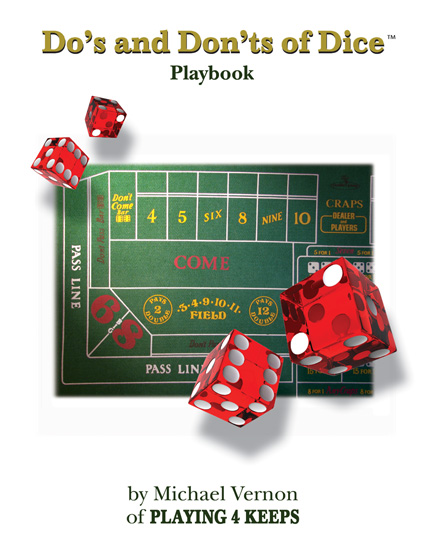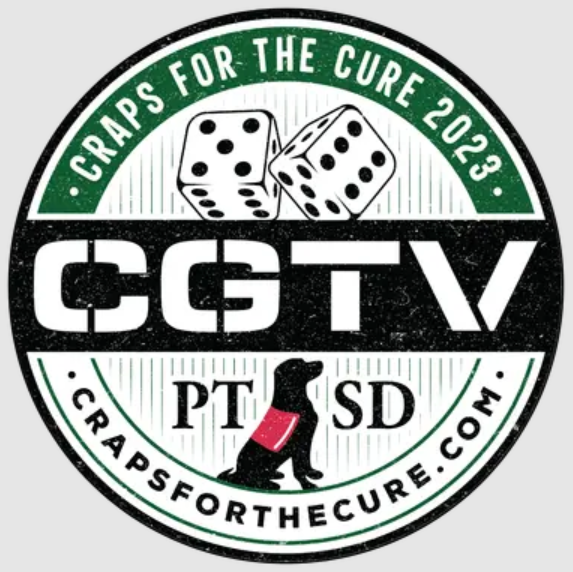|
Setting for the Don't
BY: Michael Vernon
When it comes to gambling, there is no sure system of course. The rules of the games are designed to always favor the operators of the game. Be it a game of blackjack, craps, roulette, baccarat or any of the other now popular table games, either way you play, odds are against you to win. With that understood, I want to address playing the Don't Pass and Don't Come using dice manipulation.
Before launching into the concept of dice setting and playing the Don't Pass, a bit of clarification is due. Playing the Don't Pass is often misrepresented as playing with the "House". Even in Baccarat when the bettor's choice is either the Player or the Banker, the odds never allow the bettor the same advantage as the casino. Playing the Don't Pass in a craps game is not playing with the "House". The casino has an advantage over this bet close to the same percent as a Pass Line bet. The odds favoring the casino for the Don't Pass bet are always argued by some, just like religion and politics. It is boring really. The main thing to understand is either way you bet, the odds of you losing are close enough so as to assure that the lights in the casino will keep brightly lit. For the record, the advantage over the Pass Line bet to is 1.41% and for the Don't Pass bet it is 1.36%. See for yourself http://wizardofodds.com/craps
I feel the attraction of playing the Pass Line betting has over the Don't Pass line has to do with a lack of patience mostly. Following that of course would be the necessity of a player being on the edge, engaged in the game for every roll..."Action Jackson". Playing the Don't is a grind play winning once, usually, per shooter. While on the Pass Line, a player can be like a kid in a candy store, picking several ways to bet. The problem with the Pass Line and having multiple bets is our friend, the seven. Probability predicts a seven will result in a hand once in every six rolls. That is for random rolls.
What about the players who have made a commitment to develop the skill of dice setting? Can they puck the desired numbers from the dice with their skill to set and toss the dice? Can we use dice setting, dice manipulation and what we know of skewing random results when playing the Don't Pass? Sure! Why not?
Above all, the short coming of this concept is that the player has to be the shooter. Having to be the shooter, the player must be confident with their skill with the art of dice manipulation. This means the shooter has to be able to recognize how their dice are reacting and make any necessary modifications. This statement goes to the extreme of dice manipulation and although there is a large population of dice setters playing the game, few really understand the finer points of the skill required to adjust sets and the toss in order to keep the dice out of probability. Last, in order to not become bored with the waiting game, the player has to position themselves in a game with very few players. The ideal situation would be an empty table.
Let's get to it. What does the game look like for the dice manipulator? The short scenario would be to shoot live craps on the come out on a roll. Following that would be to come out on 4 or 10, and then seven out on the second roll. That's it!
Shooting for live craps the set to use is cross sixes, left die axis 4/3 and right die axis 2/5. When set, you would have cross 6/6 on top, looking at 2/3 toward you and 5/4 on the front faces. Assuming the dice stay on axis; you are only exposed to two sevens, 1/6 and 6/1. The remaining fourteen combinations are 6/6, 1/1, 2/3, 5/4, 6/3, 2/1, 5/6, 1/4, 2/4, 5/3, 6/4, 2/6, 5/1, 1/3. However, the possible resulting outcomes are not as good as one might think.
On the come out roll 6/6 is a push for the Don't Pass. Only the 2 craps and 3 craps are live craps rolls on the come out for a Don't Pass bet. Since 5/6, Yo-11 opposes the craps number 3, and the eleven being a live roll for the Don't Pass to lose, it cancels the craps roll of 3 providing no advantage. Pushing the 12 craps and canceling the 3 craps, we are left with a one in 36 shot (1/1) using this set effectively for a natural winner on the come out playing the Don't Pass. Don't forget our friend "the seven" and with two of them (1/6, 6/1) verses (1/1), well, you can easily see how the casino manages to keep their edge.
The majority of wins for the Pass Line result from natural winners on the Come Out roll 7 or 11. Once a point is establish, the odds go to about 60% against the point to repeat. In plain language, when playing the Don't Pass, your advantage is established once you are against an established point. Once behind a point, any Don't Pass or Don't Come bet is the odds on favorite to win.
Examine now the second part of our scenario. Let's try to set a point of 4 or 10 or at least outside numbers with 5 and 9. The set to use on the Come Out roll is the 2-V with fours and tens all around. Using this set and assuming the dice stay on axis, you have two sevens to contend with, 5/2 and 2/5. The rest of the fourteen numbers are 2-fours, 2-tens, 2-eights, 2-sixes, 2-nines, 2-fives, 1-three, 1-Yo Eleven.
With the 2-V set, you have 12 out 16 combinations which can result in a box number. Of the twelve numbers, eight are outside numbers. Assuming your dice stay on axis and assuming you miss the sevens and the Yo eleven, your resulting roll will either be a winner ace/duce, 3 craps, or you will be behind a box number and favored to win.
Behind the 4 or 10 you odds of winning are 2:1. Behind the 5 or 9 your odds of winning are 3:2. Behind the 6 or 8 your odds of winning are 6:5.
Okay, we are finally behind a box number with a point established. The next step is to set for sevens and knock down the number with a seven-out. The seven set to use would depend on the point.
If the point is a 4 or 10, use a sevens set with 5/2 - 5/2axis.
If the point is a 5 or 9, use a sevens set with 4/3 - 4/3 axis.
If the point is 6 or 8, use a sevens set use either of the above sets for sevens.
This is theoretical and doable depending on the shooter's skill tossing on axis dice. In addition, the shooter must recognize how the dice are reacting and make modifications to the set and or the toss accordingly.
I am not going into betting strategies here. My purpose was to address a subscriber's question about how setting dice and shooting from the Don't could be a strategy. In short, you can play flat or lay odds and of course add a progression when you win or a modified Martingale when you lose. It really depends on the player's bankroll and their tolerance to risk.
It is easier to find a cold losing table to bet the Don't than a "working table" to bet the Pass Line. If a player is confident in their skill level with manipulating dice consistently, then shooting from the Don't could produce consistent results. For the most part, as a Don't Pass bettor, recognize that the game will not last long. Your objective should be to accept modest wins. It is imperative that when shooting from the Don't that you do not fall victim of your own cleverness. This is a game of chance and anything can and will happen. Caution is advised when shooting from the Don't that you are alert for the unexpected, catching a hand and falling on your own sword.
Click Here to return to the list of prior articles ...
|
 |










